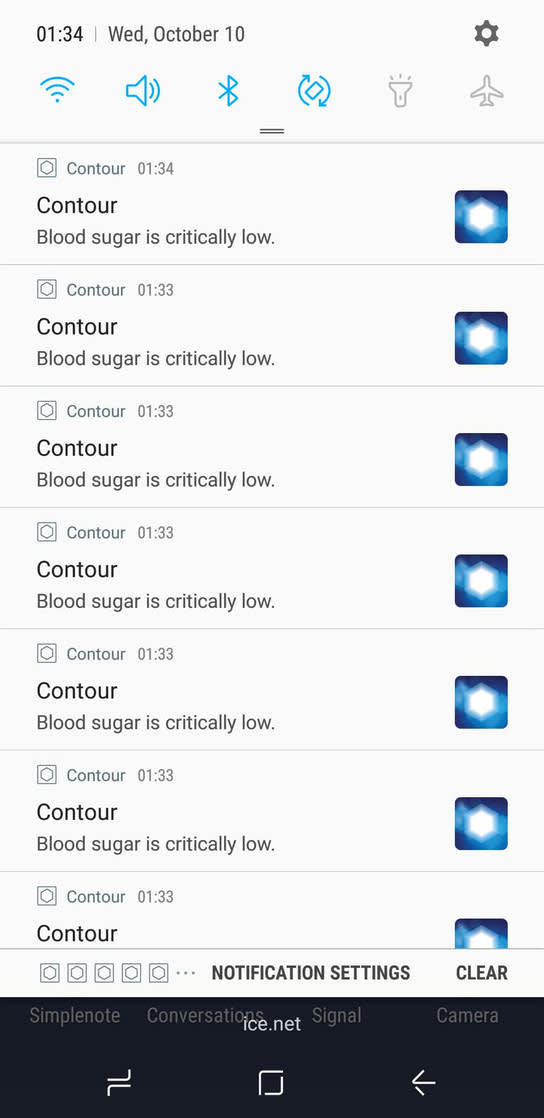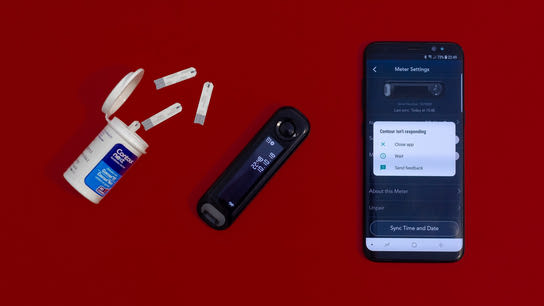I thought my new Contour Next One glucose meter with a companion phone app would work like a modern connected fitness tracker and give me convenient access to my blood sugar levels. It ended up just being more busywork.
My old glucose meter model was discontinued earlier and I needed to find a replacement model. Glucose meters seem to have been left behind while the rest of the technology sector has zoomed along with sleek minimalist designs of ever-increasing technological complexity and capabilities.
There are a handful of uninteresting glucose meters to choose from on the market. Most of them have the same aesthetics as pagers of the early 1990’s. I did find one exception though: The Countour Next One by Ascensia Diabetes Care. It’s a relatively modern glucose meter (the model is only two years old) with an “optional” companion app for Android and iOS.
The Contour Next One glucose meter itself is fine. Its easy to use and gives quick results (though it takes eight seconds and not five as advertised). The app experience on Android is just depressing, however.
I’m no fan of the Bluetooth experience. I was pleasantly surprised when the initial pairing of the Contour Next One and the Contour Diabetes app on my Nokia 7 Plus with Android 8.0 worked on the first attempt. The app gave accurate instructions and then things worked afterward. Score one for the Bluetooth experience!
In order for the meter and app to sync, you need to have the meter turned on and leave the app open at the same time. The meter uses Bluetooth Low Energy (BLE), a subset of the Bluetooth standard designed for background communications, but the app doesn’t support background sync. Just about every cheapo fitness device on the market support reading off their data without requiring the user to open an app first.
I wanted to have background sync from the glucose meter so I could pull up my phone and quickly check on “what was the last reading? and when was it?”. It’s hard to remember these things when it has become a routine you’ve been doing every day for years. I bought the Contour Next One specifically because I hoped I wouldn’t need to turn on the meter and navigate its menus on a tiny screen to find my previous reading.
I tried disabling power management policies for the app (Battery Optimization) and made sure that Bluetooth background scanning was enabled on my Android device. The documentation available from Ascensia doesn’t specifically mention whether background syncing is supposed to work or not or whether you’re required to routinely open the app when you use the meter to get pull in up-to-date data.
The app and syncing experience can be quite annoying. By default, the Contour Next One beeps loudly if you leave it turned on for more than a few seconds to remind you to turn it off. The inactivity timer on the meter doesn’t seem to be unaware that the app is actively reading data from it and beeps anyway. The app also can’t instruct the meter to power down when it has completed syncing. So, you’ve to sit there and wait for it all to do its thing and try to guess when the app has finished reading all the new data from the meter so you can turn off the meter.
You might think that this would be a good time to explore your charts, trends, and data in the app and you’d be wrong. The Contour Diabetes app does a good job of visualizing readings and analyzing trends from your measurements. Ideally, the data should help you manage your diabetes better. The app doesn’t care that you’re looking at a chart or reading about a measurement trend and will throw up full-screen dialogs for the most recent measurement. If the measurement is outside your target range it will suggest you call someone or otherwise prompt you to annotate the reading. For the best user experience, you just have to sit and wait patiently while it syncs, wait for the dialog to pop up, dismiss that, and then you can explore the app.
The app crashes frequently if you press too many things too quickly. Like when you try to quickly open a chart so you can peek at it before the app inevitably interrupts you. Dismissing the dialogs too quickly after they open can also cause the app to crash.
For a bit of variety, the app also throws up some internal error messages from time to time. I’ve no idea what these errors mean as they’re represented with meaningless error codes that aren’t documented anywhere.
These dialogs can’t always be dismissed and you’ve got to quit and restart the app instead. The dialogs and error messages appear at the same time. I’m suspecting that the app wants me to dismiss the dialog underneath the error message first, but you can’t do that when the error message is on top of it.
In , I updated my Nokia 7 Plus from Android 8.1 to 9.0 (Android One editions). The two devices were still paired, but the Contour Diabetes app refused to sync with the meter. Or rather, it failed silently at getting the job done. I’d to log out of the app, unpair the meter, log back into the app, and re-pair the meter before I got it to sync again.
Diego Pettenò noted that there are standard Bluetooth specification for glucose meters (GLP/GLS). In other words, the meter could be compatible with other apps. After some digging around, I found that the Diasend app (discontinued) should be compatible with the Contour Next One.
The app is free for customers outside the United States, and I decided to give it a go after first reviewing their Terms of Service and Privacy Policy (both policy documents leave a lot to be desired but were acceptable to me).
I installed the app, paired the meter with the phone (the meter was already paired with the phone but the app still required me to go through the motions), and the app began syncing without any issues.
However, initiating syncing in the Diasend app unlocked the hidden end-game boss-battle mode in the Contour Diabetes app. It went crazy. The app normally doesn’t sync with the meter unless the app is running in the foreground so I assumed it would be fine to use the Diasend app and not uninstalling the Contour Diabetes app first. Each app only synced while it was running in the foreground, so what would be the harm, right?

New notifications flooding in every three seconds from the Contour Diabetes app
Wrong. The Contour Diabetes app suddenly realized its life-long ambitions to be a real connected health app; on pair with your average fitness tracker and began syncing from the meter without the app being open! The Contour Diabetes app seems to have received a copy of every reading that the Diasend app retrieved from the meter and sent a notification for each reading. The meter can store up to a thousand readings so this triggered a massive flood of notifications.
My phone didn’t like this and became unresponsive to the point where I’d to force-restart the device. This didn’t clear the notification queue, however, and it started up again seconds after I’d rebooted the device. The notification flooding didn’t stop until I managed to crash the Contour Diabetes app. (As mentioned earlier, all it takes to do this is to quickly switch between different screens in the app.)
The Contour Diabetes app isn’t prefect. It feels more like a prototype than a finished product. It’s plagued with internal error screens, lock-ups, crashes, and poor performance. You can even see that it happened while I was preparing to take the feature photo for this article.
This experience isn’t just specific to just one Android device either. I’ve had the same experiences on a Samsung S8 running Android 8.0 (as seen on the feature photo) as well as the Nokia 7 Plus that I followed throughout the narrative in this article.
The app has been out for over two years and Ascensia doesn’t appear to have been able to improve the app stability and reliability in all that time.
Diabetics have gotten used to having to rely on devices that are lagging years behind the average developments in the technology sector. I’d hoped that the Contour Next One would be much better than what it turned out to be. There isn’t anything to complain about regarding the meter itself, but the Android app is just terrible.
